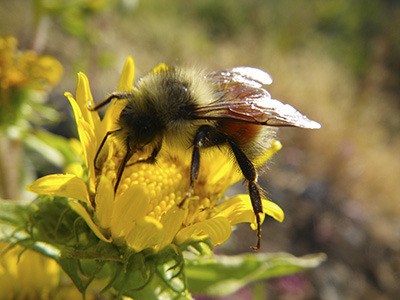By Madrona Murphy and Russel Barsh
Many people are concerned these days about the effects of cell-phones, wifi and similar devices on bees. Most scientists that study pollinators are more concerned about pesticides, however. Indeed, the European Commission voted in April 2013 to ban the use of neonicotinoid pesticides in EU member countries, while no comparable action has been taken to address claims that radio frequency signals cause bee colony collapse. So what’s behind the buzz over cell-phones?
The experimental evidence is limited to a few studies that placed cordless phone bases or cell phones in honeybee hives and observed changes in behavior. In one study, bees made warning sounds (“piping”) in the presence of active cell phones. In another study, bees were less likely to return to hives where electronic devices had been installed.
Bees’ ability to detect and avoid an electromagnetic field (EMF) does not by itself establish that EMF harms bees. Beekeepers know that piping is a response to many kinds of foreign objects. Our own bodies sense heat far below the level at which it is harmful. We taste a grain of salt (not harmful) as well as a bucket of seawater (quite bad to drink), and we smell tiny traces of sulfur dioxide (“rotten eggs”) at well below hazardous levels.
Can so-called “electrosmog” (total ambient radio frequency EMF) interfere with bee navigation? Some animals appear to orient themselves and navigate using the earth’s magnetic field, including pigeons, fruit flies, and some bats. Radio frequency EMF is not magnetic, however; unlike the low frequency EMF generated by power lines. Honeybees and bumblebees appear to be mainly visual navigators, moreover, using the angle of the sun and internal biological clocks to compute their positions.
Bumblebees have also been observed making short test flights and looking back to their nests, apparently making visual maps of their vicinity. And a study just published last fall discovered that bumblebees compute the shortest routes to flower patches before they leave their nests!
When a bumblebee lands on a flower to collect nectar and pollen, it discharges the flower’s weak static electric charge. Research published earlier this year shows that bees avoid flowers that have been discharged. Presumably they can sense the charge, the way we humans sense static electricity in our hair. This still does not link bee behavior with radio frequency EMF, any more than the human ability to feel and hear static electricity demonstrates that we can feel radio frequency transmissions.
Dr. Albert Manville of the U.S. Fish and Wildlife Service concluded in an official 2009 review of the science that “We simply do not know” how much EMF affects bees or other wildlife. He recommended further studies, but warned that they “must attempt to eliminate extraneous variables that may bias study results including diseases, parasites, weather and climatic events, pesticides, contaminants, and other mortality factors on insects and other wildlife.”
Few studies published thus far meet this test. A review of 113 studies, published earlier this year in the journal Environment International, found that while most of them reported some kind of harm from EMR, they were inconsistent with regard to the level of harm caused by any given level of EMR. If there is a direct cause-and-effect relationship between radio frequency signals and health, increasing or decreasing the electromagnetic dose should have a consistent effect on the amount of harm done.
Past studies also exposed animals to unrealistically high levels of radio frequency EMF, comparable to talking on a cell-phone for hours to days without a break. Some humans do expose themselves to that much power, but ambient levels of total RF-EMF in the environment are significantly lower.
We measured EMF levels on Lopez one June afternoon. The highest we recorded was, not surprisingly, about 50 feet from the base of the cell-phone tower: average power density per square meter was 0.4 microwatts with fluctuations to 15.8 microwatts. A few hundred feet away, at the Golf Club, average power density fell to 0.3 microwatts. Lopez Library was 0.2 microwatts and Lopez Village less than 0.1 microwatt. Except for some brief “spikes” near the base of the cell tower, our measurements were one-millionth of the exposure levels you can expect from “pressed to head” cell-phone use.
All life on earth depends on two kinds of EMR: visible light and heat (infrared). Like many other essentials of life, including electrolytes in our diet, EMF can be harmful at high doses. Very bright light harms our eyes, high heat denatures our body’s proteins, too much sodium raises our blood pressure, and high potassium levels can stop our heart. EMF is not inherently harmful. The question is: how much of any particular kind of EMF is too much?
Meanwhile, homeowners in San Juan County continue to buy products containing the neonicotinoid compound Imidacloprid, which unquestionably kills bees and has now been banned in Europe. We could tackle that threat to local bees immediately.
Kwiaht researchers are conducting baseline inventories of native pollinators in the islands. Barsh is the director of Kwiaht and Murphy is a botanist at Kwiaht. To find out more, and how you can help, write kwiaht@gmail.com.



